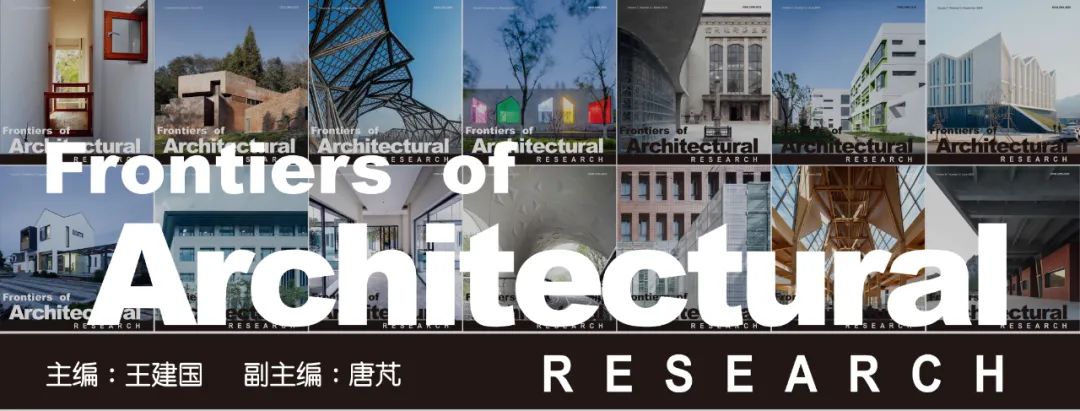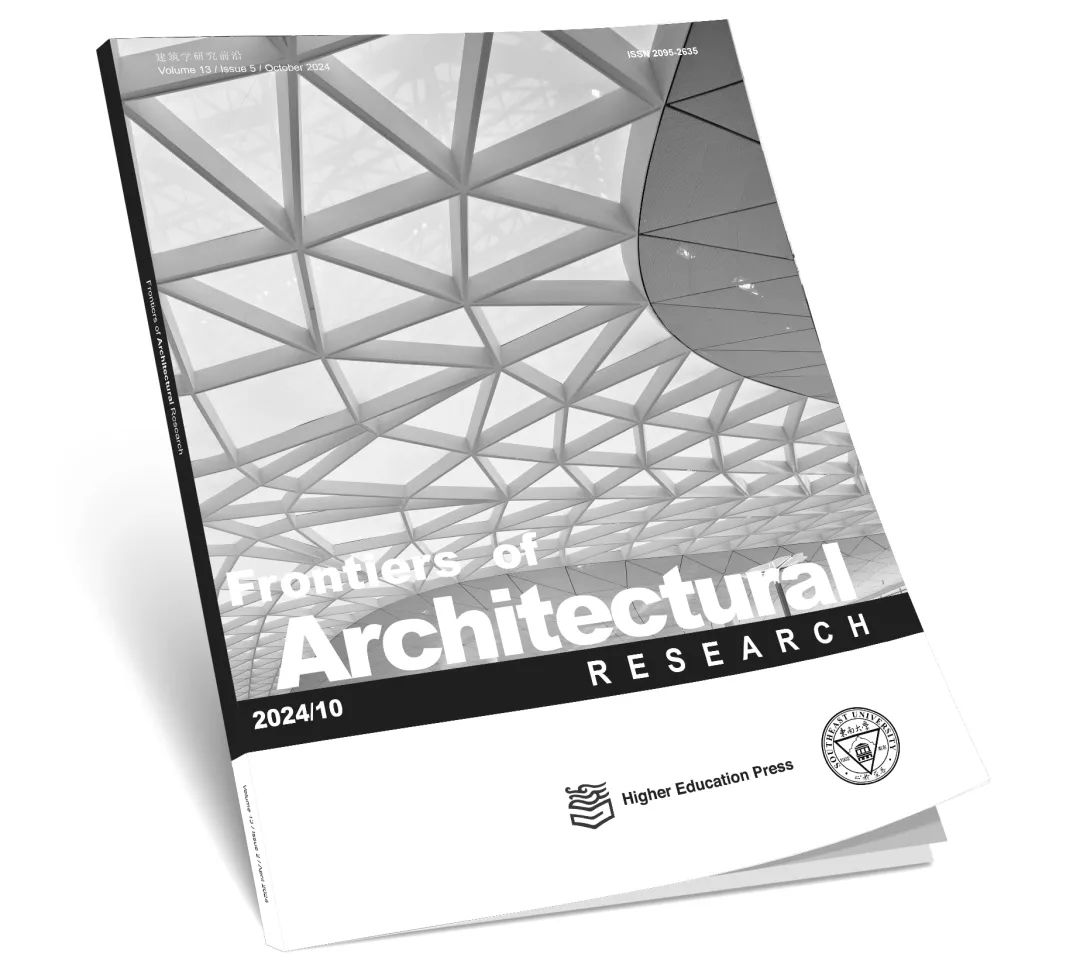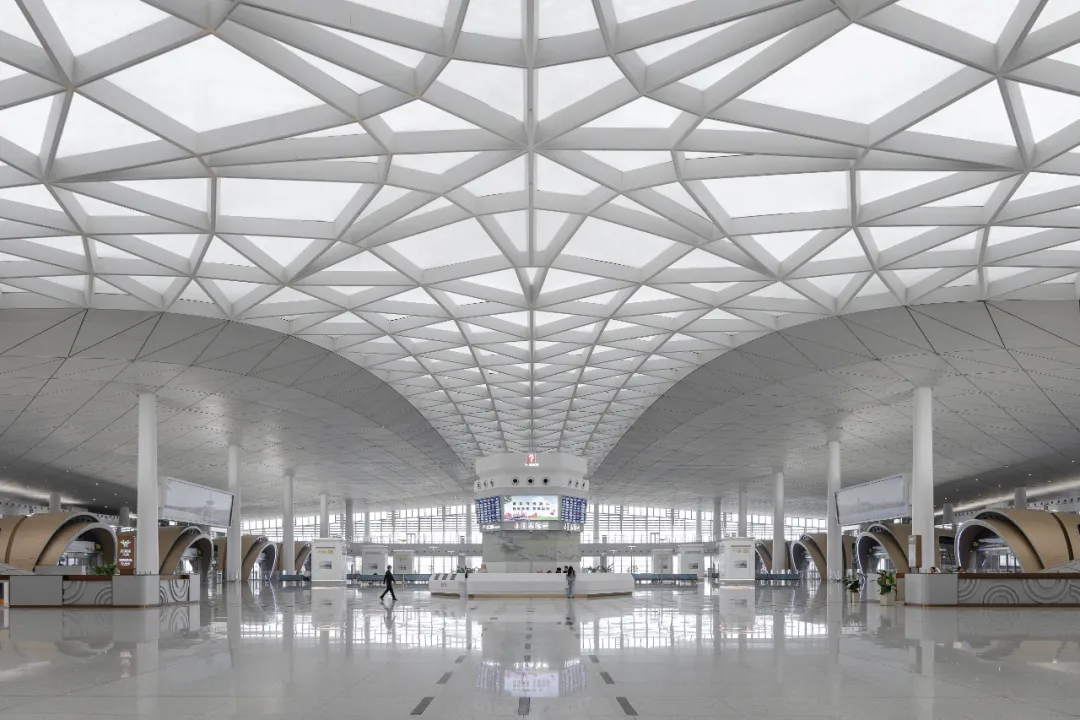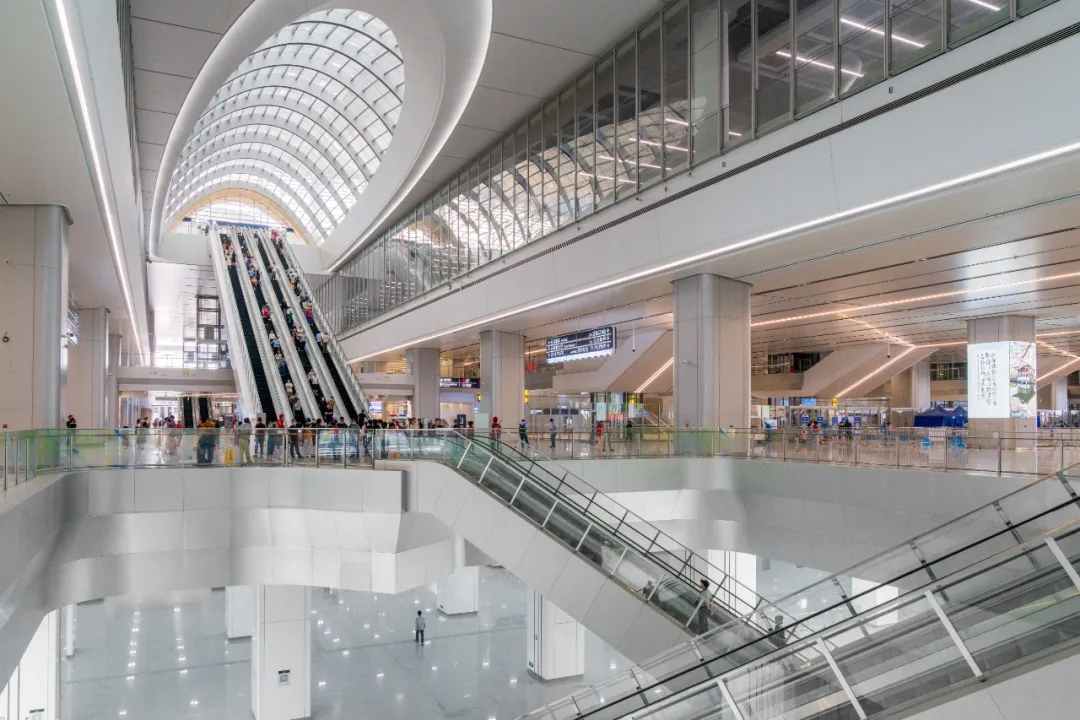
FoAR是由高等教育出版社和东南大学建筑学院联合主办的全英文学术期刊
建筑学 /城乡规划 /风景园林
本刊已被 A&HCI / CSCD / Scopus / DOAJ / CSTPCD收录
FoAR 2024年第五期已上线

Frontiers of Architectural Research是由高等教育出版社和东南大学联合主办的全英文学术期刊,是教育部重点支持的前沿系列(Frontiers)学术期刊中的一本。已被A&HCI收录。本刊于2012年创刊,2022年起改为双月刊(一年六期)。收录论文内容覆盖但不限于建筑设计及其理论、建筑科学及技术、城市研究、风景园林、建筑历史及遗产保护、绿色低碳建筑等研究领域。是一本全球发行并可开放获取(Open Access)的期刊。
Frontiers of Architectural Research优先发表创新突出、科学性和技术性强的研究论文,特定研究领域中的综述性文章和案例分析,采用严格科学方法和使用前沿技术进行研究的论文,同时也欢迎探讨建筑社会属性的高水平论文。按照国际惯例,对所有论文进行严格地同行评议并只接受英文投稿。
Frontiers of Architectural Research / FoAR
建筑学研究前沿
Volume 13 / Issue 5 / October 2024
Pages 945-1184
本期刊载了《环境行为研究》专辑(包含1篇《编者按》及6篇论文),以及其他10篇研究性论文,共17篇文章。全部文章通过严格的同行评议,内容和质量均符合本刊的定位。本期收录论文的来源分别为:中国10篇,美国、澳大利亚、日本、意大利、阿根廷、哥伦比亚各1篇。
▼
Peer Review Under Responsibility of Southeast University
东南大学负责同行评议
专辑名称: 环境行为研究
专辑学术负责人:

陆 伟
大连理工大学建筑与艺术学院 教授、博导
中国建筑学会环境行为学术委员会 副主任委员

周 颖
东南大学建筑学院
教授、博导
编 者 按
陆伟 周颖
环境行为学旨在通过人的行为与环境之间复杂相互关系的研究来为人类创造更加安全、舒适、可持续的生活环境。近年来,由于不断吸收了心理学、信息科学以及智能科学的最新成就,环境行为学蓬勃发展,目前已成为建筑学及相关领域最为活跃的分支之一。毫不夸张地说,环境行为学的研究成果正不断把建筑学推向新的高度。
本期环境行为研究专栏共收录的六篇论文展示了环境行为学的三个趋势。第一个趋势是数据庞大且来源多样。其中,陆伟教授团队和盛强教授团队均使用了基于位置的社交媒体数据,为理解人类行为与城市环境的关系提供了新视角。黄蔚欣教授团队则使用了GPS定位数据来探索个体的时空行为模式。
第二个趋势是关注当下城市的新现象与新问题。盛强教授团队对北京新兴的在线餐饮空间“共享厨房”展开了城市尺度的分析。与此同时,黄翼教授团队展开了城市更新视角下的开放社区研究。值得注意的是,陆伟教授团队和朱雪梅教授团队致力于通过优化城市环境设计来增强体育锻炼的益处,并在该领域取得了重大进展。
第三个趋势强调了环境感知的作用。环境-感知-行为框架在传统分析的基础上增加了个人如何感知和解释周围环境。该框架不仅探讨了环境因素对行为的直接影响,还探讨了主观的环境感知如何影响行为反应。黄翼教授团队利用结构方程模型评估了商业开放社区中的感知价值,为这些环境中感知和行为之间的关系提供了宝贵的见解。同样,李煜教授团队应用“界面-元素-感知”模型评估了北京市中心城市人行道的视觉景观,为视觉感知如何影响城市环境中的用户体验提供了细致入微的理解。
本期《环境行为研究》介绍了中美两国学者在该领域的最新进展。它涵盖了与环境行为相关的调查方法、实验方法和数据分析技术的新发展。这些贡献为读者提供了当前研究前沿的见解,并有望促进环境行为研究的进一步发展。
Pages 945
Editorial
Wei Lu,Ying Zhou
School of Architecture, Southeast University, Nanjing 210096, China
Pages 946-959
How urban environments affect public sentiment and physical activity using a cognitive computing framework
Peijin Sun*, Hanxu Zhao, Wei Lu
Research Section of Environment Design, School of Architecture and Fine Art, Dalian University of Technology, Dalian 116024, China
Pages 960-977
"Interface-element-perception" model to evaluation of urban sidewalk visual landscape in the core area of Beijing
Yu Li, Maiqi Li, Yuejia Xu*, Jinyao Tao
School of Architecture and Urban Planning, Beijing University of Civil Engineering and Architecture, Beijing 100044, China
Pages 978-989
Understanding children's active school commute, independent mobility, and physical activity in Austin, Texas, USA: Roles of physical environments
Xuemei Zhu (a)* , Lingyi Qiu (b), Hanwool Lee (c), Chanam Lee (c)
(a) Department of Architecture, Texas A&M University, College Station, TX, USA
(b) Huckabee College of Architecture, Texas Tech University, Lubbock, TX, USA
(c) Department of Landscape Architecture & Urban Planning, Texas A&M University, College Station, TX, USA
Pages 990-1008
Visitors' consistent stay behavior patterns within free-roaming scenic architectural complexes: Considering impacts of temporal, spatial, and environmental factors
Luying Wang (a), Weixin Huang (b)*
(a) School of Architecture, Tsinghua University, Beijing 100084, China
(b) Hang Lung Center for Real Estate, Tsinghua University, Beijing 100084, China
Pages 1009-1021
Spatial logic at different scales: An empirical study on emerging online catering in Beijing
Qiang Sheng, Zhixuan Wang*School of Architecture and Design, Beijing Jiaotong University, Beijing 100044, China
Pages 1022-1038
Evaluation of perceived value and behavioral intentions of citizens in Chinese commercially open communities: A case study of Liuyun Community
Yuanyi Xie (a), Zijian Miao (b), Xinyue Gu (c), Wenchu Zhang (d), Zipei Zhen (e), Yi Huang (b)(f)*
(a) Department of Urban Planning, College of Architecture and Urban Planning, Tongji University, Shanghai 200092, China
(b) School of Architecture, South China University of Technology, Guangzhou 510641, China
(c) Department of Land Surveying and Geo-Informatics, The Hong Kong Polytechnic University, Hong Kong 999077, China
(d) Graduate School of Design, Harvard University, Cambridge, MA 02138, USA
(e) School of Architecture, Southeast University, Nanjing 210096, China
(f) State Key Laboratory of Subtropical Building and Urban Science, South China University of Technology, Guangzhou 510641, China
▼▼▼
其余文章目录
Pages 1039-1055
Digital heritage construction: Testing the heritage value of construction documentation and building processes through Virtual Reality
Luciano Cardellicchio (a)* , Paolo Stracchi (b), Anastasia Globa (b)
(a) School of Built Environment, University of New South Wales, Sydney, Australia
(b) School of Architecture, Design & Planning, University of Sydney, Sydney, Australia
Pages 1056-1066
Unraveling the legacy of estancias: Territorial development and housing transformations in Buenos Aires
Melina YulnEscuela de Tecnologı'a, Universidad Nacional del Noroeste de la Provincia de Buenos Aires (UNNOBA), 6000 Junı'n, Argentina
Centro de Investigaciones y Transferencia del Noroeste de la Provincia de Buenos Aires (UNNOBACONICET), 2700 Pergamino, Argentina
Pages 1067-1078
A study of the inhibitory effect and mechanism of airflow regarding mould on building surfaces
Hongling Zhang (a), Hui Zhang (b), Edward Arens (b), Ling Jin (a)* , Yingdong He (c), Erxun Zhou (d), Linxuan Zhou (c), Jinhua Hu (e)
(a) School of Water Conservancy and Civil Engineering, South China Agricultural University, Guangzhou 510642, China
(b) Center for Built Environment, University of California Berkeley, CA 94720, USA
(c) College of Civil Engineering, Hunan University, Changsha 410082, China
(d) College of Plant Protection, South China Agricultural University, Guangzhou 510642, China
(e) College of Civil Engineering, Hunan University of Science and Technology, Xiangtan 411201, China
Pages 1079-1094
Does architectural design require singleobjective or multi-objective optimisation? A critical choice with a comparative study between model-based algorithms and genetic algorithms
Ran Zhang, Xiaodong Xu* , Ke Liu, Lingyu Kong, Xi Wang, Linzhi Zhao, Abudureheman AbuduwayitiSchool of Architecture, Southeast University, Nanjing 210096, China
Pages 1095-1112
Revitalizing urban spaces: Ten key lessons from the "Viaduc des arts" adaptive reuse and placemaking
D. Ben GhidaDepartment of Architecture, University of Naples Federico II Naples, Naples, Italy
Pages 1113-1126
Pilot study of the emotion cognition based on visual experience: A case study of roadside buildings in the Orio-Hibikino area
Satrio Agung Perwira (a)* , Bart Dewancker (b), Dimas Herjuno (c)
(a) Faculty of Environmental Engineering, The University of Kitakyushu, Kitakyushu, Japan
(b) Department of Architecture, The University of Kitakyushu, Kitakyushu, Japan
(c) Graduate School of Life Science and Systems Engineering, Kyushu Institute of Technology, Kitakyushu, Japan
Pages 1127-1144
Research on heritage characteristics based on railway architectural heritage database in Jinzhou section of the PekingeMukden Railway
Fuying Liu (a)(b)(c)* , Wei Qiang (a), Zuliang Lu (a), Yiheng Fan (a), Haotian Wang
(a) JangHo Architecture College, Northeastern University, Shenyang 110169, China
(b) Zhijiang College of Zhejiang University of Technology, Shaoxing 312030, China
(c) Center for Urban Governance Studies of Zhejiang Province, Hangzhou 311121, China
Pages 1145-1157
Modeling of wind-driven rain absorption ratio of building exterior finishing materials based on field measurements
Xing Hu (a), Huibo Zhang (a)* , Tianda Qian (b), Chi Feng (c)
(a) School of Design, Shanghai Jiao Tong University, Shanghai 200240, China
(b) China-UK Low Carbon College, Shanghai Jiao Tong University, Shanghai 200240, China
(c) School of Architecture and Urban Planning, Chongqing University, Chongqing 400044, China
Pages 1158-1169
Internal migrations as phenomenon of social mobility and territorial experience among architecture students, University of Tolima, Ibague', Colombia
Luisa Fernanda Ramı'rez-Lozano, Andre's Ernesto Francel-Delgado*Department of Architecture and Design, University of Tolima, Ibague' 730006299, Colombia
Pages 1170-1183
Solar Ark 3.0: A lightweight, energy-efficient house based on smooth poly-hypar surface structures
Ting Cao (a), Junjun Zhang (b), Hong Zhang (b)*, Yusong Zhu (b), Yanhua Wu (c)
(a) Department of Architecture, Harbin Institute of Technology (Shenzhen), Shenzhen 518055, China
(b) School of Architecture, Southeast University, Nanjing 210096, China
(c) Architects & Engineers CO., LTD of Southeast University, Nanjing 210096, China
在线浏览本期全部文章可扫描下方二维码
封面介绍
杭州西站

杭州西站是轨道上的长三角重要节点工程、杭州亚运会重大交通配套设施,是我国首座新建高铁正线雨棚进行综合开发的铁路枢纽、首个站场拉开设置中央进站系统的铁路站房、首次创新实现站前立体复合城市广场的交通综合体、杭州市首座交通枢纽类三星级绿色建筑。西站以云为设计意向,打造云谷、云厅、云门等空间意向新呈现,呼应杭州“三面云山一江抱城”的山水格局。杭州西站不仅是承载美好生活与便捷交通的城市会客厅,也将成为杭州面向全国乃至全球的门户形象,引领中国站城融合发展探索开启新篇章。





项目名称:杭州西站
项目客户:湖杭铁路有限公司、杭州市西站枢纽开发有限公司、沪昆铁路客运专线浙江有限责任公司、杭州市地铁集团有限责任公司、杭州上铁西站枢纽房地产开发有限公司
建成时间:2022年
设计范围:32 h㎡
建筑面积:513420 ㎡
设计单位:中铁第四勘察设计院集团有限公司、筑境设计
设计主创:程泰宁、盛晖、于晨、罗汉斌
建筑摄影:杭州西站枢纽公司、奥观建筑视觉AOGVISION、文沛、黄临海、陈畅
E N D
本文图片版权归原作者及来源机构所有
想要转载本期推送请后台留言申请授权![]()
期刊联络
高等教育出版社: 010-58556484
东南大学:025-83795543
刊物邮箱:foar@pub.seu.edu.cn
FoAR英文期刊交流QQ群:21608832
在线投稿
刊物主页
http://www.sciencedirect.com/science/journal/20952635
http://journal.hep.com.cn/foar
F o A R
长按二维码关注我们



